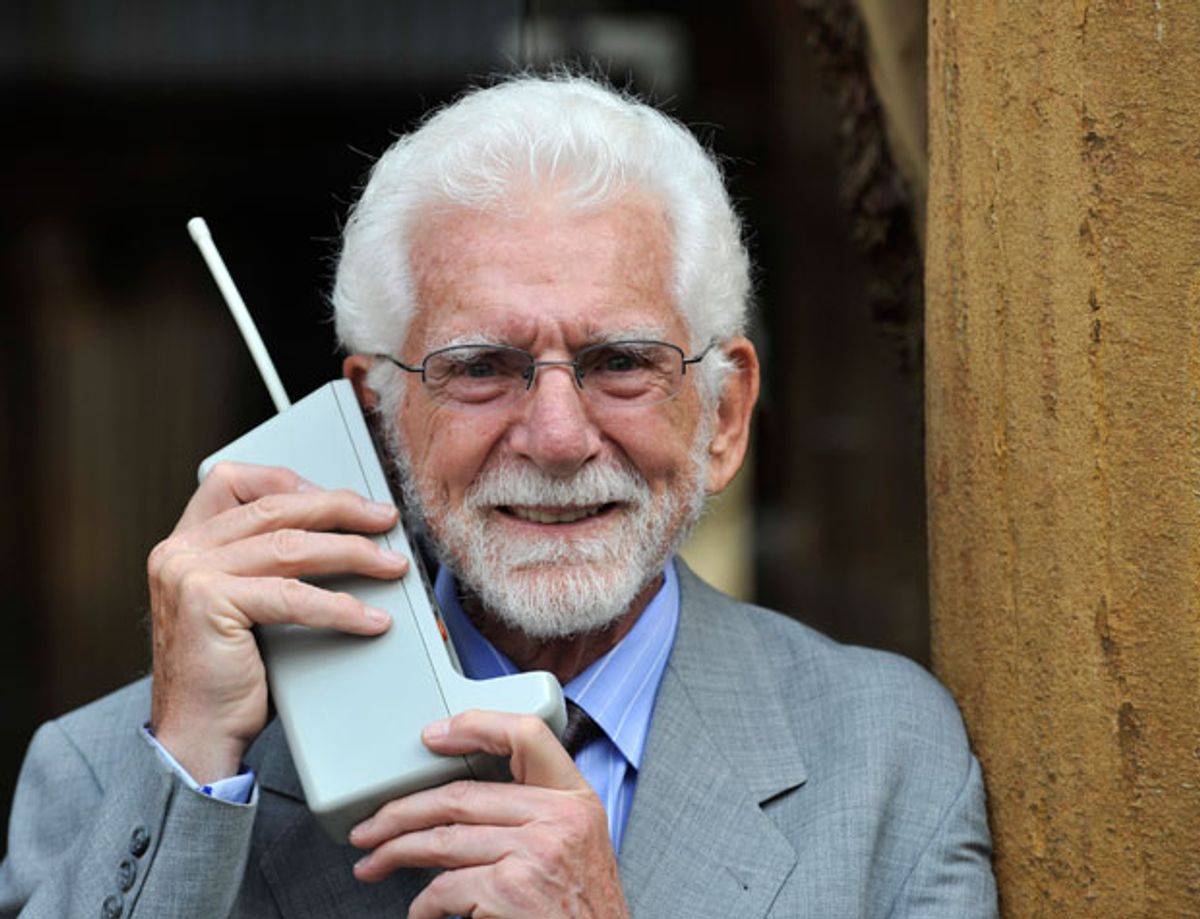Forty years ago today, Motorola announced that Martin Cooper, director of system operations at its Communication’s Systems Division, made the world’s first public call (pdf) in Manhattan on its Dyna T-A-C (Dynamic Adaptive Total Area Coverage) Portable Radio Telephone System. The Motorola press release also credits the late John Mitchell, the division’s general manager and later president of Motorola from 1980 to 1995. The press release quotes Mitchell as saying, “What this means is that in a city where the Dyna T-A- C system is installed, it will be possible to make telephone calls while riding in a taxi, walking down the city's streets, sitting in a restaurant or anywhere else a radio signal can reach.”
Cooper made his call—which was as much as a well-thought out publicity stunt as an exhibition of a revolutionary technological (and societal) capability—on his “less than three pound” phone to the landline (of course) phone of his rival and counterpart Joel Engel, at AT&T’s Bell Labs. Cooper said the purpose of the call between the two engineers was to show not only AT&T and the public what Motorola had created, but more importantly to put U.S. government regulators on notice that there could and should be competition to AT&T.
Cooper told the Wall Street Journal that the demonstration, “… had little to do with making a phone call. The whole purpose of building that phone was to shut down AT&T.”
While Cooper and Mitchell told UPI in 1973 that they expected to install the first DynaTAC portable phone network in New York by 1976, it took nearly another decade before the U.S. Federal Communications Commission (FCC) approved the DynaTAC phones for general public use. Motorola says it invested US $100 million between 1973 and 1983 to create its original cell network; its first cell phones would have set you back about $4000 in 1983 or about $9 000 in today’s currency.
According to a CBC News story, Motorola didn’t ever foresee a day when cell phones would replace landline or car phones phones: “Absolutely not” were its words at the time. Not quite a good prediction, as IEEE Spectrum editor Steven Cherry recently reported. For those too young (or not yet born) and anyone else interested in seeing why it was a big deal, there's an early Motorola DynaTAC promotion video.
The CBC News story also talks about five major events in cellphone history along with a couple of the original press releases, such as the introduction of the first smart phone in 1993 by BellSouth and IBM (pdf), the first camera phone in 2002 by Nokia and Sanyo, the first integrated phone by RIM in 2003, and the iPhone in 2007(pdf). Wired more than doubled the ante with a list of the 12 cellphones that changed everything.
The Marconi Society obviously chose the anniversary to announce today that Cooper is the 2013 winner of its Marconi Prize, which is awarded to scientists, engineers, inventors or entrepreneur for their “contributions to communications and information, and [their] determination that such knowledge be directed to the social, economic and cultural improvement of all humanity.” It's a big deal, not least for the $100 000 that goes to the awardee, but it does seem a bit belated, given than most winners haven't had to wait 40 years. Vint Cerf won in 1997 for work he mainly did in the 1980s, for example. Spectrum's longtime columnist Bob Lucky won in 1987 for inventing the adaptive equalizer in 1964. Cooper hardly had to wait at all to be designated an IEEE Fellow—he was in the class of 1976.
A couple of other technological history side notes may be of interest: Today is the 80th anniversary of the first flight over Mt. Everest and the 160th anniversary of the Otis Elevator Company.
Photo: Eloy Alonso / Reuters
Robert N. Charette is a Contributing Editor to IEEE Spectrum and an acknowledged international authority on information technology and systems risk management. A self-described “risk ecologist,” he is interested in the intersections of business, political, technological, and societal risks. Charette is an award-winning author of multiple books and numerous articles on the subjects of risk management, project and program management, innovation, and entrepreneurship. A Life Senior Member of the IEEE, Charette was a recipient of the IEEE Computer Society’s Golden Core Award in 2008.



